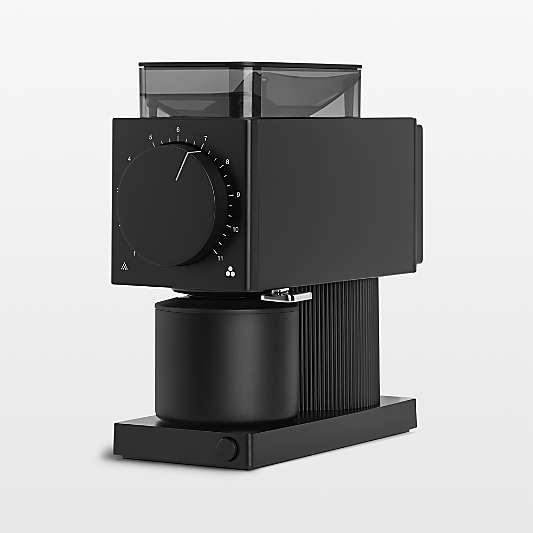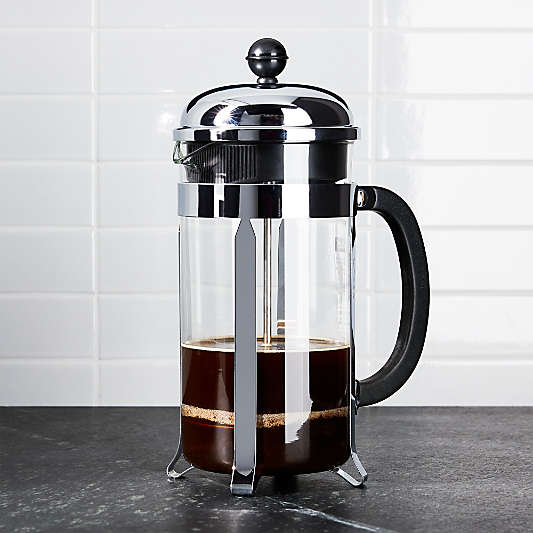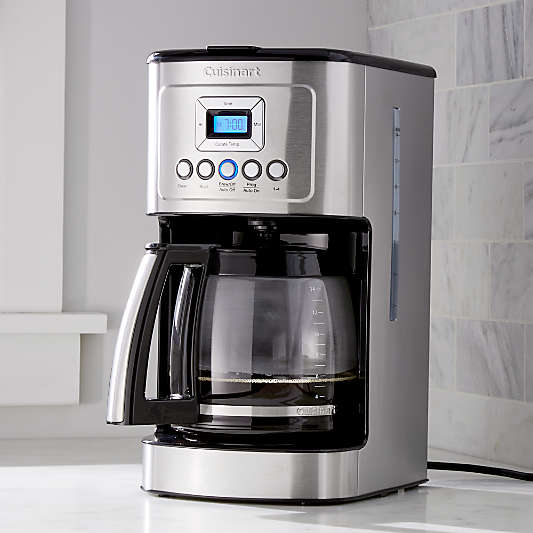8 Types of Coffee Makers: An Expert Guide on Which is Best for You
Our expert breaks down 8 common coffee maker types – and tells you how to decide between them.
Shop All coffee makers
The coffee maker may just well be one of the most loved home appliances–it’s certainly one of the most frequently used. With a machine that gets used daily (at least!), it’s important to choose one that meets your needs and preferences at the right price.
Whether you're looking for a coffee maker because you want to limit spending on to-go coffee, because you're moving to a new home or just because you're ready for an upgrade, read on to learn how to choose from the different types of coffee machines to find one that suits your needs, taste and lifestyle.
Crate & Barrel provides a curated selection of coffee makers with a wide range of brands and price points, but there’s one thing they all have in common: Each one can make great-tasting coffee. Nicole DuBois, lead kitchen electrics buyer for Crate & Barrel, vets all of the coffee makers Crate & Barrel carries. “We prioritize machines that deliver taste, quality and beautiful design,” says DuBois. “ Today’s coffee consumer is particular about quality and taste, but also values customization and personalization, so we look for those qualities in every machine we choose.”
the importance of choosing the right type of coffee machine
Some of the first things to consider when you are shopping for a coffee maker are your personal preferences including when and how you drink your coffee. You’ll want to be sure that you get something that fits your lifestyle. Be sure to consider:
STYLE OF COFFEE
Whether that’s whole beans, ground beans or convenient coffee capsules, you’ll want to make sure that coffee maker you choose can prepare the style of coffee that you like to drink.
SIZE AND NUMBER OF SERVINGS
Different types of coffee makers can prepare single serving cups or a large carafe for a crowd–or even both! Be sure to consider the needs of other household members and your entertaining style, then decide whether you should find one machine to fit all needs or get more than one option for a full coffee bar setup.
CONVENIENCE
If your morning routine is time-crunched or your counter space is limited, you’ll want to keep that in mind when shopping for your coffee machine. You can find options that require minimal clean-up, like single-serve capsule machines, or ones that don’t require an electrical outlet, such as a French press.
SPECIAL FEATURES
Need a timer? Want the option to make a latte every now and then? Love the ability to start your brew from your phone with WiFi-enabled options so it is ready when you get downstairs? These key features are more than added bonuses: They’ll bring you a smile every time
you use them.
COST
Coffee makers can range greatly in price depending on the included features. Find the best fit for your budget, but pay attention to the quality and brand reputation if you are looking for a machine that will last and provide you the best value with frequent use.
Once you’ve considered these major factors, you’ll be well on your way to selecting your perfect coffee maker.

different types of coffee makers
There are so many different types of coffee makers from drip to single-serve to pour over. We categorized these into 8 main types to make it easy to see which type is a good fit for you. With your priorities in mind, you can start to narrow down your selection.
Read on for a guide to the 8 different types of coffee makers and our recommendations on the pros and cons of each type.

drip coffee makers
When you picture a coffee maker, you might be thinking of the standard drip coffee maker. To brew using a drip coffee maker, water is added to a reservoir and then heated and run through ground beans, where it then “drips” into the coffee pot. With this type of appliance, you can customize the experience through your bean type—choosing between light, medium and dark roasts, in addition to decaf brews.
Drip coffee machines boast another advantage: the time-saving ability to use store-bought ground coffee since the default grind size in commercially ground coffee is set for this style of coffee maker. Drip coffee makers often come into two varieties: a glass carafe on a hot plate that continues to heat the coffee after brewing or a thermal carafe that maintains the temperature without an additional heating element.
USES
Single serve, large batches, families, entertaining
CLEANING INFO
After use, you’ll want to wash the coffee pot and filter basket and wipe down the machine. Be sure to follow the guidelines on cleaning your specific coffee maker provided in its use and care guide.
PROS
Lots of variety in feature options and price
Flexibility: can make one cup or many
Easy to use
Often includes a timer for automatic brewing in the morning
CONS
Daily cleaning required
Not as strong or flavorful as some other methods
Paper filters are often required or recommended
single serve coffee makers
Single serve coffee makers are typically pod- or capsule-based systems that can quickly brew a single cup of coffee. Water is put into a reservoir and then run through a capsule containing coffee grounds and brewed directly into your cup. There are capsule machines available for either an espresso-style brew or a more American-style drip coffee experience.
Many single cup coffee makers also have spouts that deliver hot water or offer pods for other warm beverages, such as cider, hot chocolate and tea. Some machines are compatible with reusable pods, giving you the option to choose your own beans. You can also find one cup coffee makers that can directly use freshly ground beans without the need for pods at all.
These machines offer true convenience. “A single serve coffee maker is a perfect choice for anyone who is time-crunched like a busy parent juggling a toddler or a college student on-the-go,” says lead kitchen electrics buyer at Crate & Barrel Nicole DuBois. With one touch of a button, you can get a cup of coffee with no cleanup needed.”
USES
Single serve, smaller households, offices and shared workspaces, small kitchenettes like college dorms and vacation rentals.
CLEANING INFO
Typically a single serve machine will require
less cleaning since you don’t have a carafe or filters to clean. You’ll want to dispose of the used capsule and wipe down any drips on the exterior. Be sure to follow the guidelines on cleaning your specific coffee maker provided in its use and care guide.
PROS
Convenience: quick to brew and go
Perfect if you only make coffee for one
Less cleaning since you brew directly into your mug or travel cup
Easy to share with others without worrying about cleanup
CONS
Capsules are additional cost to consider
Capsules can great excess waste and some don’t like the flavor
Not good for large crowds since only cup can be brewed at a time


combination coffee makers
A combination coffee maker combines two or more types of machines into one, like an espresso machine combined with a coffee maker or a single serve coffee maker combined with a multi-cup carafe. This can be a great value or provide additional functionality if you have a variety of needs, like usually only needing one cup of coffee in the morning but then also wanting an option for entertaining.
Another type of combination coffee maker is called a grind and brew, meaning that it has an integrated grinder. You start with fresh beans and they are ground directly into the filter basket, removing the step of transferring coffee grounds from the grinder to the coffee maker.
USES
Multipurpose, single serve, entertaining, families, espresso
CLEANING INFO
After use, you’ll want to wash the coffee pot and filter basket and wipe down the machine. With combination coffee makers there may be additional components to clean. Be sure to follow the guidelines on cleaning your specific coffee maker provided in its use and care guide.
PROS
Great value with multiple uses
Saves space over having two separate machines
Great compromise to keep multiple family members happy
Ability to make different types of coffee for different occasions
CONS
You may sacrifice some features you like for the combination features
Added expense if you don’t end up using the additional features
french press coffee makers
French press coffee has a rich and full-bodied taste. Almost-boiling water and fresh, coarsely ground coffee beans are combined in the French press to steep for about 4 minutes. Then, just before serving, the grounds are pressed into the bottom of the carafe to keep them out of the final cup of coffee.
Because no paper filters are involved, this style of coffee includes oil from the beans, resulting in a complex flavor profile. This process is highly customizable, giving connoisseurs the ability to modify temperature and brew time. French presses are also smaller in size and don’t require an electrical outlet because the process is manual.
USES
Single serve, smaller households, travel, coffee aficionados who love full bodied coffee
CLEANING INFO
After disposing of the used grounds, hand wash the French press and components and let air dry. Be sure to follow the guidelines on cleaning your specific coffee maker provided in its use and care guide.
PROS
Small and portable
Rich, unfiltered coffee flavor
Plastic-free way to brew coffee
No electricity required
No paper filters required
Simple to make
CONS
Multiple pieces to wash
Often made of glass that is easier to break
Not good for entertaining a large crowd
Requires freshly ground coffee that is a coarser grind than what is typically available in the grocery store


pour over coffee makers
For those wanting a boutique coffee shop experience and lots of control over the final result, a pour over is a great option. Typically, when using a pour over coffee maker, you’ll want some additional equipment including a gooseneck kettle with temperature control, a burr grinder and a food scale to ensure the proper beans-to-water ratio.
Freshly ground coffee is placed in a filter in the pour over coffee maker and then hot water is added slowly in batches to fully extract the flavor from the grounds. This method provides the most opportunity for personalization according to taste preferences and is very hands-on. Pour over fans typically praise the finished coffee as being the smoothest and best-tasting option.
USES
Single serve, smaller households, smaller countertop space, coffee drinkers who prize taste and smoothness.
CLEANING INFO
A pour over coffee maker will typically need
to be washed by hand. Be sure to follow the guidelines on cleaning your specific coffee maker provided in its use and care guide.
PROS
Rich-tasting, smooth and customizable coffee
True coffeeshop experience at home
Full, even extraction of coffee grounds
CONS
Slower, hands-on process–can’t multitask
Glass carafe can be easier to break
Works best with a gooseneck kettle which could be an additional purchase
Special paper filters required
cold brew coffee makers
Cold brew coffee is a method where coffee grounds are combined with cold or room temperature water over a period of hours or overnight. The brewed coffee is then filtered or stored in another container and can therefore be made ahead and stored in the refrigerator. A cold brew coffee maker is often a vessel with a spout where this slow extraction takes place.
Many people find the flavor of cold brew to be less bitter or acidic than traditionally hot brewed coffee, even when served iced.
USES
Iced coffee, make ahead, small or large batches, baking
CLEANING INFO
A cold brew coffee maker will often have to be hand washed. Be sure to follow the guidelines on cleaning your specific coffee maker provided in its use and care guide.
PROS
Ability to make mellow cold brew at home
Low tech
Easy to use
Can make ahead coffee for a few days using the refrigerator
CONS
Several parts to clean
Takes several hours


iced coffee makers
The basic way of making iced coffee is to pour hot coffee over ice. If your coffee machine does not have a cold brew setting but makes iced coffee, this is typically what is happening. You can utilize a more concentrated setting so that when the hot coffee goes over ice, it is not diluted too much.
If you enjoy iced coffee, you can look for a coffee maker that offers an iced coffee setting. You’ll usually have the option to brew hot coffee on the same machine as well.
USES
Iced coffee, hot coffee, single serve, multi-cup, all seasons entertaining.
CLEANING INFO
Be sure to follow the guidelines on cleaning your specific coffee maker provided in its use and care guide.
PROS
Ready to drink iced coffee
Multipurpose machine
Fast way to make iced coffee
CONS
Can taste more acidic if what you are looking for is actually
Cold brew
Coffee can taste diluted
specialty coffee makers
ESPRESSO MACHINES
Espresso machines are distinct from coffee makers. An espresso machine forces hot pressurized water through
tightly packed coffee grounds to produce a concentrated
form of coffee. There are 3 main types of espresso machines: automatic, semi-automatic and manual.
STOVETOP COFFEE MAKER
A stovetop coffee maker does not require electricity, but instead can be used on top of a burner to heat the water within. A Moka pot and a stovetop percolator are two types
of stovetop coffee makers.
MOKA POT
A moka pot is a stovetop espresso maker that relies on
steam to create the pressure needed for the classic espresso taste. As the water boils, the extracted coffee is sent from the bottom to the top of the pot through a connecting spout. Moka pots have been a popular choice for decades for their simplicity and versatility and ability to be used as the base of all kinds of strong espresso style drinks.
AEROPRESS®
The AeroPress® is a versatile plastic coffee brewer that allows for customization and full-immersion brewing. Because this device uses a paper filter, pressure and a fast brewing time
(2½ minutes), the resulting coffee is mellow, yet strong and rounded.
TURKISH COFFEE MAKER
Turkish coffee is brewed in a small pot with a long handle. Very finely ground beans are combined with water and the pot is placed on the stovetop to boil. Turkish coffee is typically served unfiltered in small cups.
VIETNAMESE COFFEE MAKER
A Vietnamese coffee maker is also called a phin and the brewed method is similar to a single serve pour over where hot water is poured over the grounds and drips into a vessel below. A phin typically has a metal filter so a paper filter is not required.
SIPHON COFFEE MAKER
A siphon coffee maker brews coffee using two chambers. Water is added to the bottom chamber and when heated, water vapor moves
to the upper chamber to mix with coffee grounds. Once the coffee maker is removed from the heat source, a vacuum is created and the brewed coffee returns to the bottom chamber.
PERCOLATORS
A coffee percolator is a kettle-like device that is available in both electric and stovetop versions. Hot water is continuously cycled through coffee grounds to create an increasingly stronger cup.

by: Crate & Barrel Editor
|6 min read










































